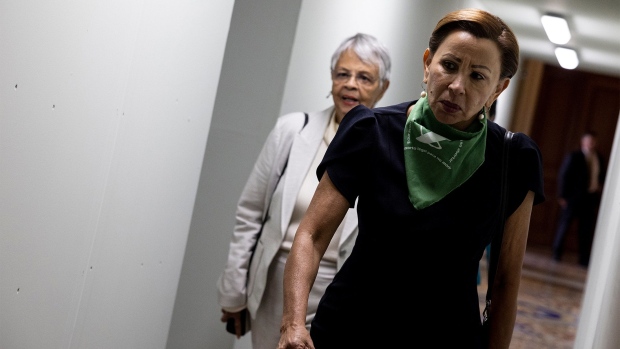Jun 24, 2022
How Green Became the International Color of Abortion Rights
, Bloomberg News

(Bloomberg) -- As abortion-rights activists took to the streets to protest the Supreme Court decision striking down Roe v. Wade on Friday, some wore green scarves, shirts and other pieces of clothing. Others held up signs with green lettering or background.
The color became a symbol of resistance to anti-abortion laws during pro-abortion activist efforts in Argentina. Then it was taken up by organizers in other Latin American countries, and it has since spread around the world. The green bandana first appeared in 2015, worn by activists in the “ni una menos” or “not one less” movement who were protesting violence against women in Argentina, according to Amnesty International. Argentina legalized abortion in December 2020, and the symbol became known as the “marea verde,” or the “green wave.”
Read More: ‘Let Your Rage be Seen and Heard!’ Here’s Where Activists Have Planned Abortion-Rights Rallies
Women’s rights issues have been a struggle in Argentina for decades, and abortion rights activists adapted symbols from earlier generations. The Campaña Nacional por el Derecho al Aborto, or National Campaign for the Right to Abortion, selected green scarves in a nod to a 1970 and 1980ss activist group. Then, the Madres de Plaza de Mayo, or Mothers of Plaza de Mayo, took to the streets in white scarves to protest the brutal dictatorship and the disappearance of between 13,000 and 30,000 people, according to the Washington Post.
US Takes Up the Green Bandana
The green bandana has also appeared at protests in Poland, decrying the country’s near-total abortion ban went into effect in January 2021. Activists at US rallies have also adopted the symbol. Green could be spotted at protests against the leaked Supreme Court draft in May and again at demonstrations against the June 24 decision for Dobbs v. Jackson Women’s Health Organization. The color is even present in the halls of Congress. Nydia Velazquez, a Democrat representing New York, wore a green bandana on Capitol grounds in May, while her colleague, Washington Democrat Pramila Jayapal, was pictured wearing a green ribbon on her blazer.
“The work that has been done by tireless advocates throughout Latin America is sparking waves of progress on women’s access to reproductive health care throughout the globe,” Velazquez told Refinery29.
Abortion Rights Abroad
The US Supreme Court’s decision to overturn of Roe v. Wade and wipe out the constitutional right to an abortion stands in contrast to the decriminalization and legalization of the procedure in other countries — and especially in Latin America. Colombia followed Argentina in legalizing abortion in February 2022. Mexico decriminalized the procedure in September 2021, with nine of the country’s 32 federal entities recognizing a person’s legal right to an abortion, including Mexico City, Oaxaca and Gurrero.
Read More: What Happens When Women Get Illegal Abortions in Post-Roe America
Six countries in Latin America and the Caribbean have a total ban on abortion: the Dominican Republic, Haiti, Jamaica, Honduras, Nicaragua, and El Salvador. People who seek abortions in El Salvador can be found guilty of “aggravated homicide,” a risk also for those who have miscarriages, according to the BBC. Some countries have come close to carving out exceptions to complete bans. In Haiti, a penal code introduced in 2020 that would potentially make some abortions legal on the basis of rape, incest or if the person’s life is endangered, has been put on hold after protests from religious groups. Those who succeed in getting an abortion in Haiti can serve a life sentence in prison, according to the International Campaign for Women’s Right to Safe Abortion. After the Dominican Republic failed to decriminalize abortion in certain cases in March 2021, hundreds activists protested for a month, according to NBC News.
©2022 Bloomberg L.P.